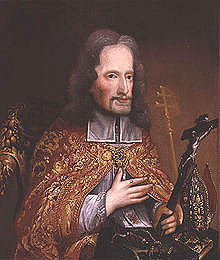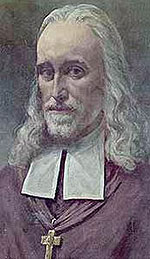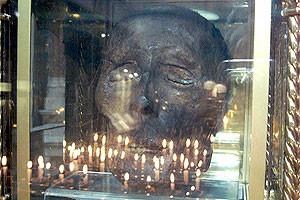| |

Traditions, folklore, history and more. If it's Irish, it's here. Or will be!
"People will not look forward to posterity who never look backward to their ancestors."
-Edmund Burke




Quotes
Library: Books, Movies, Music
Prints & Photos
Poetry
Jokes


Shops Ireland
Bunús na Gaeilge
(Basic Irish)
Circle of Prayer
Blessings
Did You Know?
Himself/Herself
Write to Us
Readers Write..
Links/Link to Us
Advertise with us
Awards & Testimonials
Submissions Guide


|
|
|
 St. Oliver Plunkett St. Oliver Plunkett
by Bridget Haggerty
Oliver Plunkett was born in 1629 in Loughcrew, County Meath, Ireland to well-to-do parents of Hiberno-Norman origin. He was related by birth to a number of landed families, such as the recently ennobled Earl of Roscommon, as well as the long-established Earl of Fingall, Lord Louth and Lord Dunsany. Until his sixteenth year, the boy's education was entrusted to his cousin Patrick Plunkett, Abbot of St Mary's, Dublin, and brother of the first Earl of Fingall who later became bishop, successively, of Ardagh and Meath. As an aspirant to the priesthood, he set out for Rome in 1647, under the care of Father Pierfrancesco Scarampi, of the Roman Oratory. At this time, the Irish Confederate Wars were raging in Ireland; these were essentially conflicts between native Irish Roman Catholics, English, and Irish Anglicans and Protestants. Scarampi was the Papal envoy to the Roman Catholic movement known as the Confederation of Ireland. Many of Plunkett's relatives were involved in this organisation
He was admitted to the Irish College in Rome and he proved to be an able pupil. He was ordained a priest in 1654, and deputed by the Irish bishops to act as their representative in Rome. Meanwhile, the Cromwellian conquest of Ireland (1649–53) had defeated the Roman Catholic cause in Ireland and, in the aftermath, the public practice of Roman Catholicism was banned and Roman Catholic clergy were executed. As a result, it was impossible for Plunkett to return to Ireland for many years. He petitioned to remain in Rome and, in 1657, became a professor of theology. Throughout the period of the Commonwealth and the first years of Charles II's reign, he successfully pleaded the cause of the Irish Roman Church, and also served as theological professor at the College of Propaganda Fide. At the Congregation of Propaganda Fide on July 9, 1669, he was appointed Archbishop of Armagh, the Irish primatial see, and was consecrated on November 30 at Ghent by the Bishop of Ghent, He eventually set foot on Irish soil again on March 7, 1670, as the English Restoration of 1660 had started on a tolerant basis. The pallium was granted him in the Consistory of July 28, 1670.
After arriving back in Ireland, he set about reorganising the ravaged Roman Church and built schools both for the young and for clergy, whom he found 'ignorant in moral theology and controversies'. He tackled drunkenness among the clergy, writing 'Let us remove this defect from an Irish priest, and he will be a saint'. The Penal Laws had been relaxed in line with the Declaration of Breda in 1660 and he was able to establish a Jesuit College in Drogheda in 1670. A year later 150 students attended the college.
 1673 brought a renewal of religious persecution, and bishops were banned by edict. Archbishop Plunkett went into hiding, suffering a great deal from cold and hunger. His many letters showed his determination not to abandon his people, but to remain a faithful shepherd. He thanked God "Who gave us the grace to suffer for the chair of Peter." The persecution eased a little and he was able to move more openly among his people. In 1679 he was arrested and falsely charged with treason. He maintained his duties in Ireland in the face of English persecution and was eventually arrested and tried for treason. He was brought from a prison cell in Dublin Castle to face trial in Dundalk, during which he made no objection to the all-Protestant jury. The prosecution witnesses were themselves wanted men and afraid to turn up in court, so the trial soon collapsed. Because of a common belief that no jury in Ireland would ever convict him, irrespective of its makeup, Archbishop Plunkett was then transferred to face trial in Westminster Hall, London. 1673 brought a renewal of religious persecution, and bishops were banned by edict. Archbishop Plunkett went into hiding, suffering a great deal from cold and hunger. His many letters showed his determination not to abandon his people, but to remain a faithful shepherd. He thanked God "Who gave us the grace to suffer for the chair of Peter." The persecution eased a little and he was able to move more openly among his people. In 1679 he was arrested and falsely charged with treason. He maintained his duties in Ireland in the face of English persecution and was eventually arrested and tried for treason. He was brought from a prison cell in Dublin Castle to face trial in Dundalk, during which he made no objection to the all-Protestant jury. The prosecution witnesses were themselves wanted men and afraid to turn up in court, so the trial soon collapsed. Because of a common belief that no jury in Ireland would ever convict him, irrespective of its makeup, Archbishop Plunkett was then transferred to face trial in Westminster Hall, London.
His trial has often been described as a travesty of justice as he was again denied defending counsel, time to assemble his defence witnesses and he was also frustrated in his attempts to obtain the criminal records of those who were to give evidence against him. His servant James McKenna and a relative John Plunkett had travelled back to Ireland and failed within the time available to bring back witnesses and evidence for the defence. During the trial Archbishop Plunkett had disputed the right of the court to try him in England and he also drew attention to the criminal past of the witnesses, but all to no avail. Lord Chief Justice Pemberton addressing these complaints said to the accused, "Look you, Mr. Plunket, it is in vain for you to talk and make this discourse here now..."[1] and later on again, “Look you Mr Plunket, don't mis-spend your own time; for the more you trifle in these things, the less time you will have for your defence".[2] In passing judgement the Chief Justice said: “You have done as much as you could to dishonour God in this case; for the bottom of your treason was your setting up your false religion, than which there is not any thing more displeasing to God, or more pernicious to mankind in the world.”.[3] The jury returned within fifteen minutes with a guilty verdict and Archbishop Plunkett replied: “Deo Gratias” (Latin for "Thanks be to God"). He was hanged, drawn and quartered at Tyburn on 1 July 1681, the last Roman Catholic martyr to die in England.
 Immediately after the execution, Elizabeth Shelton, who was from a highly regarded Catholic family, succeeded in petitioning the King for the remains. Most of the venerated body is today interred at Downside Abbey, England, but the head and two forearms were saved and certified. They were entrusted to the Dominican Convent in Drogheda and are now on view, enshrined in St Peter's Catholic Church in Drogheda, along with the door of the cell Oliver Plunkett occupied at Newgate. Pilgrims from all over the world visit the Shrine of St Oliver Plunkett to venerate the relics of their glorious martyr, and many miracles have been recorded. Immediately after the execution, Elizabeth Shelton, who was from a highly regarded Catholic family, succeeded in petitioning the King for the remains. Most of the venerated body is today interred at Downside Abbey, England, but the head and two forearms were saved and certified. They were entrusted to the Dominican Convent in Drogheda and are now on view, enshrined in St Peter's Catholic Church in Drogheda, along with the door of the cell Oliver Plunkett occupied at Newgate. Pilgrims from all over the world visit the Shrine of St Oliver Plunkett to venerate the relics of their glorious martyr, and many miracles have been recorded.
The saint was beatified on Pentecost Sunday in 1920 and canonised by Pope Paul VI in October 12, in 1975, the first new Irish saint for almost seven hundred years and the first of the Irish martyrs to be beatified. For the canonisation, the customary second miracle was waived. He has since been followed by 17 other Irish martyrs who were beatified by Pope John Paul II in 1992. Among them were Archbishop Dermot O'Hurley, Margaret Ball, and the Wexford Martyrs.
His ministry during its time was most successful and he confirmed over 48,000 people over a four-year period. In 1997, he became a patron saint for peace and reconciliation in Ireland, adopted by the prayer group campaigning for peace in Ireland, 'St Oliver Plunkett for Peace and Reconciliation'. His feast day day is July 11.
Content & Image Sources:
Catholic On-line
Wikipedia
Irish Identity
|
|
Thu, Apr 4, 2024
 Ilnacullen, Co. Cork - an Island Garden Ilnacullen, Co. Cork - an Island Garden
Located in the sheltered harbour of Glengarriff in Bantry Bay. Ilnacullin, which means island of holly, is a small island known to horticulturists and lovers of trees and shrubs all around the world as an island garden of rare beauty.
The vivid colours of Rhododendrons and Azaleas reach their peak during May and June, whilst the hundreds of cultivars of climbing plants, herbaceous perennials and choice shrubs dominate the midsummer period from June to August.
Because of its sheltered situation and the warming oceanic influence of the Gulf Stream, the climate is favourable to the growth of ornamental plants from many parts of the world.
Even for those who aren’t particularly interested in gardens, there are many other scenic views, especially in the surrounding waters where seals frequent the rocks on the southern shore.
The cover photo on Bridget's book The Traditional Irish Wedding shows a wrought iron garden gate on Ilnaculen. I took that photo. To see it, go to the home page. It's part of the opening paragraph Failte.
—Russ
Resource: Copy and Image - Cork Guide
Click for More Culture Corner.
...made for television movie is entertaining, inspiring, and educational. St. Patrick is one of the most well known, yet least "known about" significant personalities in world history.
Amazon Reviewer
Available in VHS or DVD, Click below for The Irish Legend Movie.
Click for VHS.
Click for DVD.
|
|
|
|
|




 Ilnacullen, Co. Cork - an Island Garden
Ilnacullen, Co. Cork - an Island Garden